

Why Apple will combine iPad and Mac but not iPadOS and macOS
source link: https://uxplanet.org/why-apple-will-combine-ipad-and-mac-but-not-ipados-and-macos-658960d9aff7
Go to the source link to view the article. You can view the picture content, updated content and better typesetting reading experience. If the link is broken, please click the button below to view the snapshot at that time.
Why Apple will combine iPad and Mac but not iPadOS and macOS
And no, I’m not talking about dual boot.
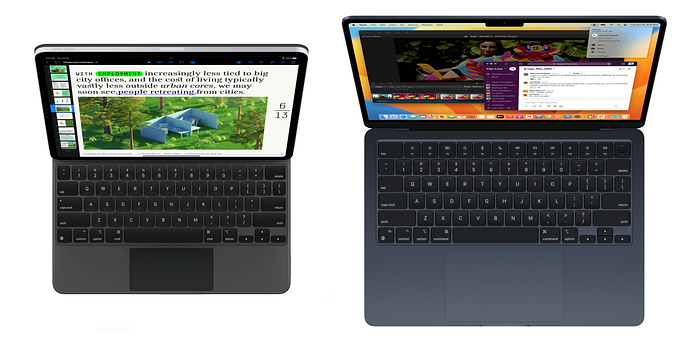
The two platforms
For many years, the old elite of the Mac community has been worried about the existence of their open computing device, with all the niche features of a full-fledged desktop operating system (short: OS), and for many years Apple has claimed that it does not want to merge Mac and iPad.
Yet it seems to be only a matter of time until Apple will change its computing lineup, as the coexistence of two different platforms that are increasingly competing in terms of functionality does not appear to make sustainable sense.
The existence of two mainstream computing OS’s is no long-term solution because the effort to build apps for two OS’s is too great for developers — even with Apple’s efforts like Catalyst. That’s the current situation we have with iPad: Powerful hardware + OS, but a lack of pro apps. Not even Apple has managed to make iPad-versions of their pro apps like the video editing app Final Cut Pro, and instead had to present a competitor product on their website: DaVinci Resolve for iPad.

Image from Apple
The user interface of both platforms is just too different, and simply checking a box to port an app from one platform to the other leads to a compromised user experience.
Instead iPadOS needs to become the mainstream OS it’s destined to be — with all the pro and non-pro apps people need. People shouldn’t have to choose between modern OS (iPadOS) and a classic OS (macOS). MacOS will become a niche OS, because it is just unnecessarily too much for the vast majority of people.
In the last years Apple has shown a strong willingness to give iPadOS all the features it need to replace macOS for most users: Cursor-control, split-screen-multitasking, all the context menus with all the features, customizable toolbars, resizable windows (Stage Manager) and external display support (coming with iPadOS 16.2).
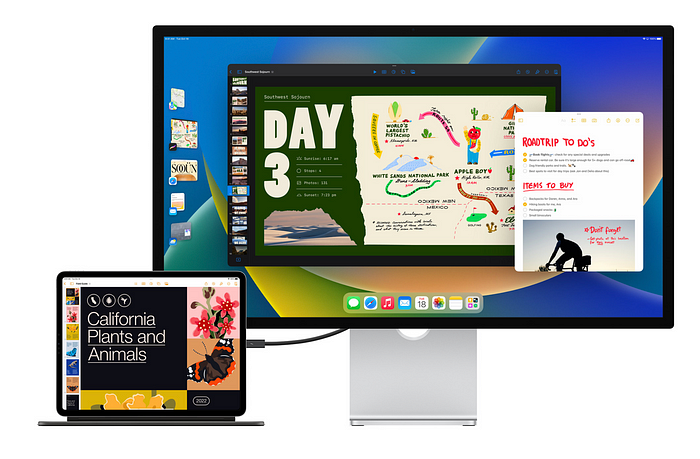
Image from Apple
MacOS, on the other hand, has received many of the apps and features that came originally from iOS and iPadOS, but it has not evolved as a platform with its own innovations, like it did in the beginning of the 2010s, e.g. with the introduction of Mission Control. MacOS’ current native window management is too restricted and maintenance-intensive, compared to iPadOS’ fluid experience.

Image from Apple
The laptop from factor
But what’s stopping iPadOS from becoming the mainstream OS? It’s iPad. Not everyone wants a tablet that can become a half-baked laptop through cumbersome keyboard accessories. A large portion of the people just want a laptop that you can simply fold open, and that is fully lapable — by that I mean the ability to have it sit stably on your lap.
Currently only the Magic Keyboard for the iPad Pro features real lapability — because it has just one surface that sits on your lap, and the weight of the iPad is balanced by hanging over the keyboard with a stiff hinge. But is has two major drawbacks: There is no space for a row of function keys, and the size of the trackpad is on par with laptops from 15 years ago.
The Magic Keyboard Folio for the normal iPad has room for a row of function keys — but at the cost of lapability, like the Microsoft Surface Pro, because it has a kickstand that can fall back over, and because the bottom and top part (keyboard and iPad) are not connected by a stiff hinge.
For the iPad to replace a MacBook for most people, it needs to offer all the features of a laptop, including a equivalent keyboard and a full size trackpad.
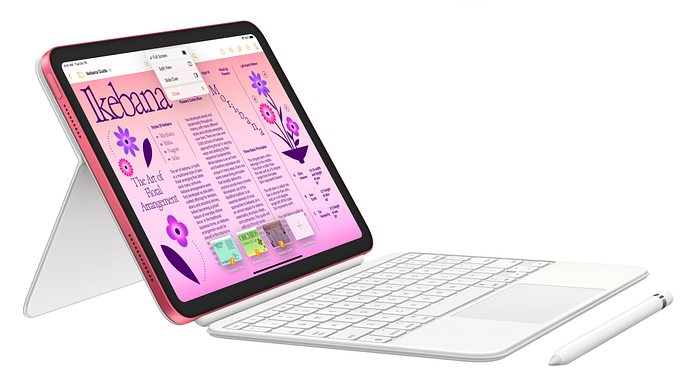
Image from Apple
The laptop-tablet hybrid form factor
But just offering a MacBook with iPadOS isn’t the solution. People shouldn’t have to choose between a touch-tablet and a non-touch-laptop. But simply making the display of a laptop touch-capable isn’t the solution either. Like Steve Jobs famously said, no one wants to hold their arm up to the display for more than a few minutes.
An iPadOS-device with full laptop capabilities should also be able to function like a tablet. But the windows hybrid laptops, that allow the screen to be folded all the way back to the bottom of the device have a major drawback: The keyboard and trackpad are exposed and can be scratched by the surface the device in tablet-mode is placed on. And when you hold the device in your hands, you unpleasantly press the keys on the back.
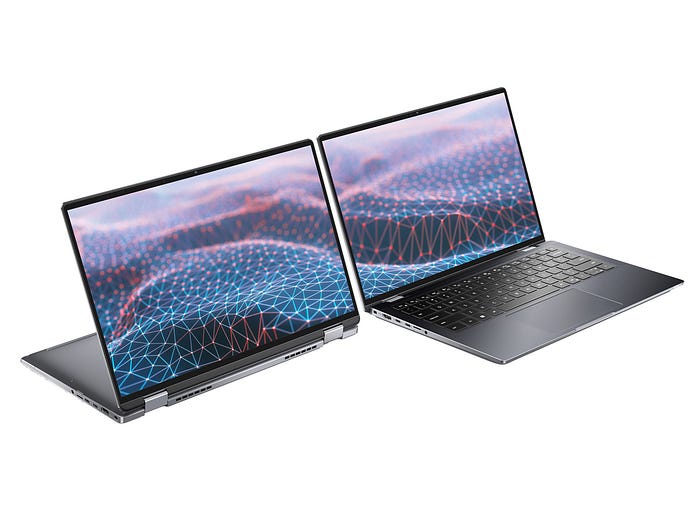
Image from Notebookcheck
Some will object that fingerprints are annoying on a hybrid laptop, but this is not a problem on the iPad, which has a grease-repellent coating. A hybrid device also doesn’t have to be thick like the old Microsoft Surface Book. The joints can be very small and elegant, like in the Lenovo Yoga. With Apples power-efficient M-chips, a hybrid device could be thin and light, yet very powerful.
There have been repeated rumors and patents that Apple is working on a device that can be opened like a laptop, but that has a second large display instead of the keyboard and trackpad, on which they are displayed as software. This device could perhaps even have a large folding display, so that the device could be used like a giant tablet when opened flat.
However, even if this device would have a Taptic Engine (like the iPhone) so that the software keyboard would provide haptic feedback, it would not be a replacement for real keys. The history of MacBooks shows how important a good feeling, physical keyboard is.
A possible hybrid solution is a detachable display that can function as a tablet and a bottom component (keyboard) weighted down by an extra battery, among other things. But such devices like the old Microsoft Surface Book are, among other disadvantages, unnecessarily heavy, as they have to compensate for the weight of the tablet display.
Other hybrid laptops like the Dell XPS 12 with a display that sits vertically rotatable in the display frame, and the discontinued HP EliteBook Revolve, with a horizontal rotatable display, have other drawbacks beyond the scope of this article.
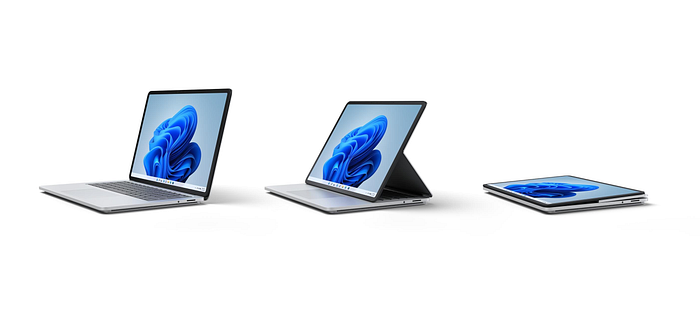
Image from Microsoft
Introducing iPadBook
Laptops like the Microsoft Surface Laptop Studio or the HP Elite Folio show how hybrid devices can be more elegant. Not unlike the Magic Keyboard for the iPad Pro, the screen can be pulled forward and also folded completely flat, so that the keyboard and trackpad are protected. Since the display here is only a display, their weight distribution is perfectly lapable.
Of course, these devices are still primarily a laptop, but they are also well suited for use as a tablet — and they could probably be build with the same thickness as the iPad Pro between the two halves of the Magic Keyboard when closed.
Such an iPadBook is the future of MacBooks for most people (who wouldn’t buy a MacBook and an iPad anyway). Just as the iPad possesses an uncompromising tablet form factor with compromised lapability (+keyboard & trackpad), the iPadBook would possess an uncompromising laptop form factor with a compromised tablet function, for those who prefer such a variant.
Most importantly, both devices would run the same modern OS, allowing developers to reach the vast majority of all users by developing their apps for only one platform. And people who prefer the laptop form factor would not be confronted with a totally different OS.
The iPadBook would be superior to the MacBook Air in terms of hardware and software for the average user.
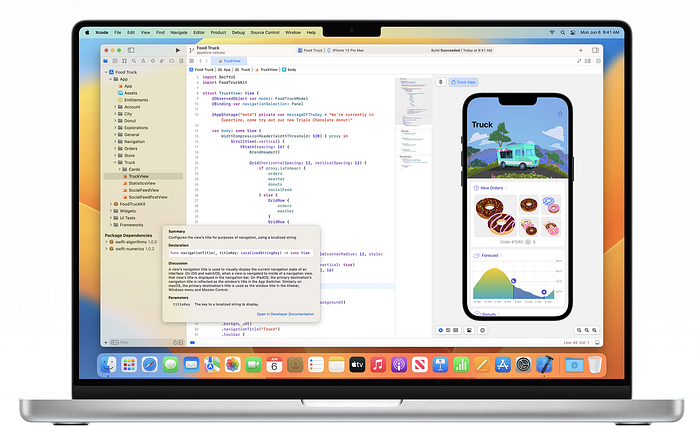
Image from Apple
Taking the pressure off macOS
But what will become of macOS? It will always be the computer for the rest of us. Because it can do things that iPadOS never will but that is still necessary. But there will only be a small percentage of people who need the openness and legacy compatibility of macOS. Everyone else will be used to the closeness and tidiness of a modern OS like iPadOS.
And with iPadOS being the mainstream OS, there is no pressure on macOS to modernise. Apple can focus on implementing all the stuff nerds and professionals need.
Mark my words. 🙌🏻
Recommend
About Joyk
Aggregate valuable and interesting links.
Joyk means Joy of geeK